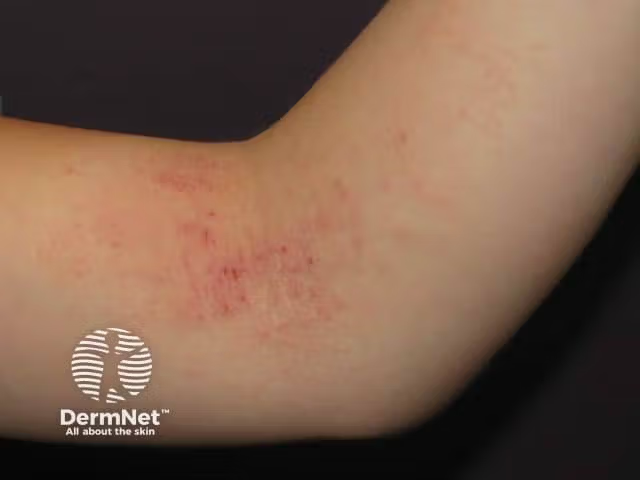- Acne
- Actinic Keratosis
- Aesthetics
- Alopecia
- Atopic Dermatitis
- Buy-and-Bill
- COVID-19
- Case-Based Roundtable
- Chronic Hand Eczema
- Drug Watch
- Eczema
- General Dermatology
- Hidradenitis Suppurativa
- Melasma
- NP and PA
- Pediatric Dermatology
- Pigmentary Disorders
- Practice Management
- Precision Medicine and Biologics
- Prurigo Nodularis
- Psoriasis
- Psoriatic Arthritis
- Rare Disease
- Rosacea
- Skin Cancer
- Vitiligo
- Wound Care
Opinion
Video
Top Considerations From Latest AAD AD Guidelines
Author(s):
Raj Chovatiya, MD, PhD, gives an overview of what all clinicians need to know about the updated atopic dermatitis guidelines published by the American Academy of Dermatology including approaches with systemic therapies, which therapeutic modalities to prioritize, and patient considerations to guide decision-making.
In the Dermatology Times Expert Perspectives series "Advancements in Atopic Dermatitis: Insights from the 2024 Masterclasses in Dermatology Conference," leading dermatologists discuss the advancements in treatments and data for atopic dermatitis (AD) with hand-foot involvement, diversity in clinical trials, and pearls from the American Academy of Dermatology's (AAD) AD treatment guidelines.
In this episode, Raj Chovatiya, MD, PhD, clinical associate professor at the Rosalind Franklin University Medical School and founder of the Center for Medical Dermatology and Immunology Research in Chicago, Illinois, delves into considerations for the AAD's new guidelines.
The AAD updated its guidelines for the first time since 2014 with recommendations for AD management in patients who do not respond to topical therapies. After their comprehensive review, the academy recommended the use of dupilumab (Dupixent), tralokinumab (Adbry), baricitinib (Olumiant), abrocitinib (Cibinqo), and upadacitinib (Rinvoq); conditionally recommend phototherapy, cyclosporine, methotrexate, azathioprine, and mycophenolate; and do not recommend systemic corticosteroids.1
Episode Transcript
Chovatiya: It's been a while since we've last had an update of the guidelines for AD by the AAD. The last set was 2014. We've been waiting for what seems like about a decade, given that we've had so many new therapeutics. It's amazing that we finally have a new set of guidelines. And now while I don't necessarily think it may change my approach to care, I think the power is that, with so much new data and therapeutics, we have something to point to anytime there is an impediment for us to get a patient from a topical therapy to a systemic therapy and just given the high quality of evidence for multiple biologic and multiple oral therapies. It's wonderful to see that we have real data and practical guidance suggesting that if a patient is not getting to goals on a topical, whether that be for symptoms or signs of disease, there really shouldn't be anything stopping us from getting them to have the right therapy, as it's the medically responsible and the agreed upon thing to do.
You know, the one thing dermatologists decry is no matter how much data we have or how many guidelines we have, it is always access issues that really stop us up and access can come in many different flavors or forms. One can just be the idea that you need to try 1 medication for getting to another medication. The other just might be that this isn't really necessarily the thing that there's a lot of data behind, and so we don't really want to recommend that. Now in both of these instances, that guide then should really help to ease that problem when you do have to do a peer-to-peer or some type of updated argument for why this is the right therapy. Now we can point to these guidelines to say, "Look, we have high level and high quality data, and a lot of it to suggest that biologic therapies like dupilumab or tralokinumab or oral therapies like abrocitinib or upadacitinib, even baricitinib." Frankly as far as their guidelines go, all have enough evidence behind them that this would be the right thing to do. So I really shouldn't have to be waste time with things like cyclosporine, methotrexate, or even oral steroids that are not necessarily approved options nor ranked as highly when it comes to thinking about systemic therapies for our patients.
So when it comes to treatment decisions in AD, it's a joint decision between the patient and the health care provider and the name of the game here is shared-decision making. And this can mean a lot of different things to a lot of different folks, but the core principle is true. When you have a lot of different choices, all of which may have fairly good evidence behind them. You really need to go beyond just what is efficacy and safety but incorporate patient preference into the actual discussion. So in somebody may have a preference for an oral therapy or injectable somebody might be inherently highly or lowly risk tolerance speed may be of essence to somebody in frequency of dosing may be important to somebody and each of those can be overlaid upon the overall data we think about on the package insert to really help guide what the right decision might be. I think it's important to note that there is probably usually never one singular correct decision, but rather it's going to be different and unique based on the individual patient scenario. Patients are looking for a lot of different things when it comes to AD. So they may be interested in something that's going to work extremely quickly. They might be interested in something that they can use everyday or maybe don't have to use every day. Perhaps it's something that has a route of administration that is very familiar to them. Maybe it's long term data that really resonates with them. Maybe it's just the cleanest possible safety profile was no chance anything is gonna go wrong. I think those are really the factors that helped to dictate what might be the right therapeutic choice in terms of the overall patient makeup and demographic factors. Most of our medications all seem to work across very different groups of patients. And so that's why I usually say that understanding where the patient is coming from and what might be something they're looking for oftentimes can be the deciding factor when all other things are held equal.
Transcript edited for clarity
Reference
1. Davis DMR, Drucker AM, Alikhan A, et al. Guidelines of care for the management of atopic dermatitis in adults with phototherapy and systemic therapies. J Am Acad Dermatol. 2024;90(2):e43-e56. doi:10.1016/j.jaad.2023.08.102










